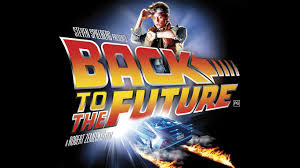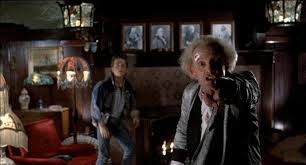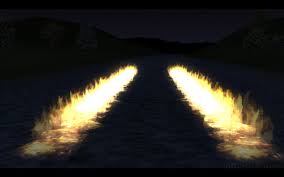Going Back to the Future in our Worship
 This weekend is the 30th anniversary of the release of Back to the Future, a film that some theorize is the most perfect example of a summer blockbuster.
This weekend is the 30th anniversary of the release of Back to the Future, a film that some theorize is the most perfect example of a summer blockbuster.
For those of you who are unfamiliar with the film (all two of you), it is about Marty McFly, a teenager who, through a series of contrivances, goes back into time, and runs into his parents when they were teenagers, before they were in love with each other. In doing so, he had inadvertantly risked his own very existence when his teenager mother, not knowing who he is, falls for him. He has to undo the damage done, while being at the right place/time, procuring a specific lightning strike that can give his time machine the right amount of “jigowatts”, to corral him back to present times.
The movie has a lot of humor and action, but most importantly, it is built upon nostalgia. Those who grew up in the 1950s could reminisce, some thirty years later, how things were back then, while later audiences could get a vivid picture of what life was like.
Interestingly enough, this movie has aged extremely well, because now it has a double-nostalgia effect. We not only reminisce about an idyllic 50s culture, but now also about an 80s culture. The movie is an essential 80s artifact, as seminal as Raiders of the Lost Ark and Return of the Jedi (both of which, incidentally, were also rooted in 30s-movie-serials nostalgia).
What does this have to do with worship music?
The State of Current Worship Music
I don’t want to be the harbinger of bad tidings. I recognize that many people love today’s current crop of worship songs. I do, too, to an extent. But I cannot ignore some of the negative aspects of worship today.
The biggest problem is that congregations are simply not singing as they once were.
One of the greatest attributes of praise and worship music, when it was first introduced, was its accessibility to the average congregant; instead of sounding stodgy and formal (like an organ-based hymn or a chorale), it was something a person can relate to and sing robustly, a song for their generation.
Over the decades, from the Jesus-music hippie era in the 60s and 70s, to the rise of the worship music conglomerates Maranatha, Integrity/Hosanna and Vineyard, (not to mention the Catholic publishing houses like North American Liturgical Resources and F.E.L. publications), worship music has evolved. Their most lasting contribution came by way of a subscription model approach to worship, every couple of months a new recording is released, more worship songs that your congregation could possibly use.
In 1997, there began a shift as to how worship music was to be perceived. Christian contemporary pop groups like SonicFlood began covering beloved worship songs that youth groups had embraced, but with a highly professional touch that was radio friendly. Delirious and Matt Redman began writing worship songs that appealed to not only churches and youth groups, but also to radio stations. And in Atlanta, an annual event commenced called “Passion” introduced college audiences to high energy worship experiences that were later marketed and sold.
This has been a wonderful flourishing of great new worship songs that have been embraced by new generations. But the drawback is that there is far less congregational singing being done; contemporary churches have become extensions of Christian radio—churning out hit after hit, while congregations have become content to just let the professionals do the singing.
We have to go [hear this with Doc Brown’s voice] “back… to the future!”

We have to go back… to the future!
Retracing Our Steps
When somebody loses their car keys, they retrace their steps to find out where they were when something gets lost. Subsequently, we need to retrace our own steps to find out what it was that had changed in worship music that had caused a downturn in congregational participation.
From my vantage point, the most seminal aspects of contemporary worship music that deter actual singing, are the following:
- Too many songs being introduced without letting them resonate.
- Verse melodies that are not accessible to the average congregant, either because the range is too high/too low, or the musical phrasing is inconsistent.
- An over-emphasis in emotionalism in worship, usually typified by an adept female worship leader.
- Too many parts: there used to be a single (hymns) or dual (verse-chorus) melodic hook; nowadays, you have verse, pre-chorus, chorus, bridge, and repeated outro verses. It’s too complicated.
To quote one of these newer songs, we need to “get back to the heart of worship, where it’s all about You, it’s all about You, Jesus.” We also need to remember that singing that song does not mean that the goal has been attained.
An Action Plan
So… how to do this, without falling back into dated sounds of decades past?
In all my years of leading worship, the most enthusiastic response I’ve gotten from congregants has—surprise, surprise—not been from introducing the latest and greatest worship song; the reason is because it usually takes three listens for a new song to take root and a congregation begins to accept it. No.
The most enthusiastic response is when I reintroduce an older song, one that had once been a paragon for that worship community, but has since been forgotten. “I have not sung that song in years!” But… I do this using contemporary music forms that have been embraced since then (like uses of partial capos, as but one example).
My favorite approach is to medley these older forgotten classics with the newer songs. Remember that an established hymn like “How Great Thou Art” got a resurgence in use simply because it flowed so easily from Chris Tomlin’s seminal “How Great Is Our God.” Finding these medley flows is a process wherein you discover these proper worship pairings by way of finding songs with the same tempo, time signature, key, and theme.
Earlier this week I was revamping a songbook for a men’s prayer group that I attend. And in doing so, I found I had a number of musical vacancies that could be filled. Instead of searching for newer songs, I focused on forgotten songs that the group had sung before I was an attendee, and I found that there were new song medleys that could be introduced.
One example is by taking the current song “Lamb of God” by Tenth Avenue North, and pairing it with forgotten Vineyard classic “One Holy Passion” by Andy Park. After aligning the songs in the same singable key (in this case, A-minor), the choruses flow perfectly into each other:
You are holy / You are worthy / You are holy / You’re the Lamb of God
Holy, Holy Holy Lord, God Almighty, I adore
Your glory, now my eyes can see,
You’re the King who reigns in majesty
When I rediscovered these older songs, and paired them with the newer ones, I saw that there was a lot that both songs could gain by being paired with each other. The first song is focused on approaching God in His awesome holiness, whereas the second song’s verses focuses on how I can return to the world, after a deep encounter with Christ.
This is but one example of many song pairings that I had newly discovered. And anybody can do this.
The Results of Re-Introducing Old Standards
The experience of a person singing a song they used to sing, but had been dormant for years, is priceless. The enthusiasm that was once there, returns, in full force. The song comes back from the inner recesses of their long term memory, along with all the emotions that had resonated from back then. Suddenly a bridge between generations is formed, and newer generations get a taste of songs that had dominated the worship scene from before their time, only to sense that such songs can be timeless.
I also want to reiterate… this is not just about praise and worship songs from prior decades. This works equally, adeptly well with those same “stodgy, formal hymns” that I referenced earlier in this post. In fact, many of the most singable current praise songs of today are merely reintroductions to these older hymns, albeit with a more contemporary spin. Suddenly one has the benefits of both worlds—solid theology and poetry intermingled with a contemporary sound.
I think this can go back even further, using any musical style of worship, from spirituals to plainchant. We live in a time where it has become easier to embrace such diversity, by way of instant access to YouTube videos and instructional blog posts; it is high time we take advantage of our resources.
Worship is a journey; it is our collective journey to the great throne-room. Getting there in this manner may be, for you, a different road than before. But we can never lose sight that… “Where we are going, we don’t need roads.”

I am in the process of creating a series of new webinars. Can you help me? Please fill out a two minute survey. You would be doing me a great favor. Thanks.









Another big factor in congregational singing…. Does the priest sing?
If the priest is not comfortable singing I guarantee that the congregation will eventually quiet down even if they were once strong singers. Years ago our parish priest actually stopped a song and told the congregation “We WILL be a singing congregation!” He had the music group start over and wouldn’t end mass until people participated. From that day over 20 years ago to this day, our parish is an amazing singing parish. Three priests later, that singing culture that was established still lives. I’ve been to congregations where the priest looked like he hated singing and watched as the few who did sing were mentally browbeaten to silence.